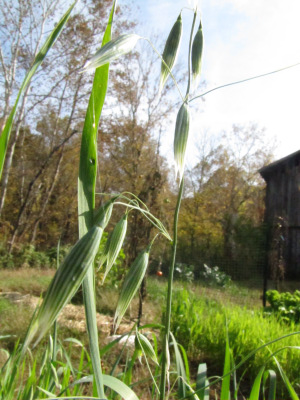
Late fall cover crops
 Just
a week after noticing that the
six week old buckwheat was going to
seed, I saw these
beautiful oat flowers popping out of my two month old
oats. Since I'm growing the oats as a cover crop right now, I
went ahead and mowed them down with the hedge trimmer.
Incidentally, the hedge trimmer got slightly bogged down in the
thickest parts of the oat beds, so I wouldn't want to use it on
anything tougher than ripening oat stalks.
Just
a week after noticing that the
six week old buckwheat was going to
seed, I saw these
beautiful oat flowers popping out of my two month old
oats. Since I'm growing the oats as a cover crop right now, I
went ahead and mowed them down with the hedge trimmer.
Incidentally, the hedge trimmer got slightly bogged down in the
thickest parts of the oat beds, so I wouldn't want to use it on
anything tougher than ripening oat stalks.
Meanwhile, I'm
continuing to go a little overboard testing out every
possible autumn cover
crop. Two
weeks ago, I planted
several beds with crimson clover, the only fall-planted legume cover
crop that is supposed to be at least semi-reliably winter-killed in our
region.
Early October is late to be planting crimson clover, but the seeds are
already up and I have high hopes we'll get enough growth to give me an
idea of the quality of the variety before our first hard freeze.
I've got a lot more beds
opened up now that the summer garden is
officially dead, so I'm going to try out one last cover crop this year
--- barley. If you're curious about the pros and cons of
different cover crops in your region, I highly recommend that you
download Managing
Cover Crops Profitably.
This 4.5 MB, 248 page pdf file gives a lot of regional pointers that
will help
you figure out which cover crops are worth a shot and which ones should
be avoided at all costs. The results you'll get from a cover crop
are highly dependent on your climate and soil, so it's worth doing a
bit of research rather than just planting the cover crops that have
done well on someone else's farm.
Want more in-depth information? Browse through our books.
Or explore more posts by date or by subject.
About us: Anna Hess and Mark Hamilton spent over a decade living self-sufficiently in the mountains of Virginia before moving north to start over from scratch in the foothills of Ohio. They've experimented with permaculture, no-till gardening, trailersteading, home-based microbusinesses and much more, writing about their adventures in both blogs and books.
Want to be notified when new comments are posted on this page? Click on the RSS button after you add a comment to subscribe to the comment feed, or simply check the box beside "email replies to me" while writing your comment.
- Remove comment
- Remove comment
